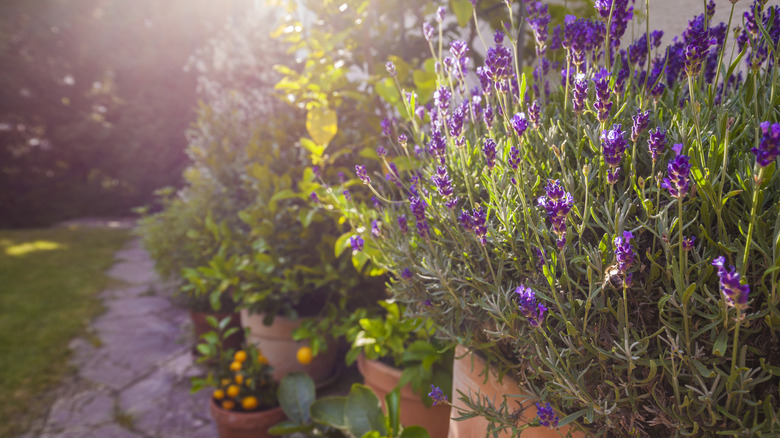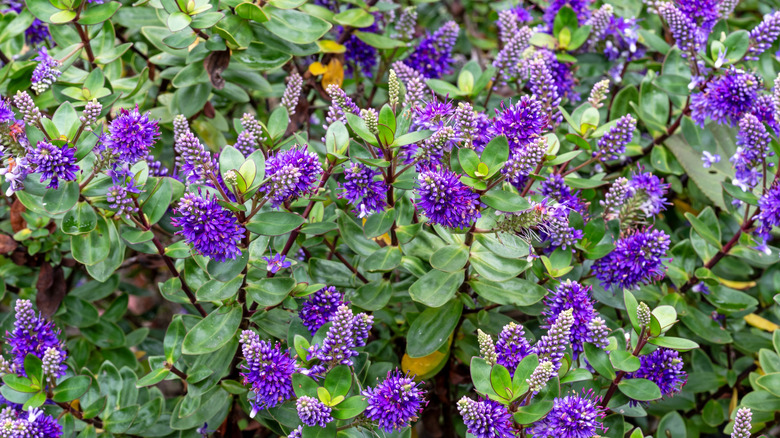The Fast-Growing Lavender Alternative That Is The Perfect Border Plant For Sunny Gardens
If you live somewhere with hot, humid, or soggy weather, keeping lavender (Lavandula spp.) alive can be challenging. Planting a lavender lookalike that thrives in your climate is a solution worth exploring. There are several stunning lavender alternatives that might work in your garden. One option to consider is the 'Garden Beauty Blue' cultivar of hebe, a quick-to-grow evergreen that's sometimes called shrubby veronica. Since most hebes are native to New Zealand's warm climate, they also thrive in USDA hardiness zones 8 through 11 in the United States. Some varieties of this easy-care shrub, including 'Garden Beauty Blue, are hardy in zone 7 as well. When their needs and preferences are met, hebes will grow 6 to 12 inches annually. 'Garden Beauty Blue' usually reaches a height of 20 inches or so. Its short stature and condensed shape make it a nice choice for cottage gardens and border plantings, especially when taller plants are placed behind it.
The flower spikes that 'Garden Beauty Blue' produces contain small, tube-shaped blossoms that are a striking shade of blue-purple, similar to lavender blossoms. As with lavender, you can grow 'Garden Beauty Blue' in a pot or plant it beside paths, patios, and other parts of your yard's landscape. Many gardeners grow lavender to entice pollinators, which love the high nectar content of its flowers. 'Garden Beauty Blue' is just as skilled at attracting bees, butterflies, and other insects eager for a sweet drink. Both plants aren't very appealing to deer, and birds appreciate the hiding places provided by hebes' dense foliage.
Caring for 'Garden Beauty Blue' hebes
Some gardeners find hebes easier to grow than lavender because they're not as fussy about soil or moisture. Lavender craves soil that's a bit stony or sandy, but hebes are willing to grow in a wide range of soil textures. Though 'Garden Beauty Blue' needs its soil to drain water efficiently, it generally appreciates some dampness. Lavender, on the other hand, prefers slightly dry soil and is prone to root rot and leaf spot in wet conditions. Beyond this, lavender and 'Garden Beauty Blue' have similar growing preferences. Lavender and hebes love full sun but tolerate partial shade. Plus, both prefer soil with a neutral-to-alkaline pH level.
Like most hebes, 'Garden Beauty Blue' excels when planted in the spring. If possible, wait until the danger of frost has passed since young hebe plants can be overwhelmed by chilly conditions. If your planting site has clay soil, consider amending it with compost to improve its drainage before putting 'Garden Beauty Blue' in the ground. Also mulch this site annually to regulate moisture and temperature, making sure to rake old mulch before laying down a new layer. Hebes don't tolerate drought as well as lavender, so water 'Garden Beauty Blue' frequently, especially when rainstorms are few and far between. Also give your hebes regular drinks in the winter so they don't get parched.
Sometimes 'Garden Beauty Blue' hebes can sometimes be tricky to find at U.S.-based nurseries. However, you're likely to come across another purple variety that's just as pretty and a suitable substitute for lavender. A few other violet-flowered hebes to consider are 'Amy,' 'Autumn Glory, 'Champion,' and 'Garden Beauty Purple.'

